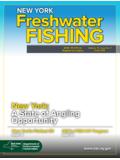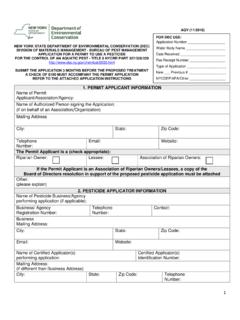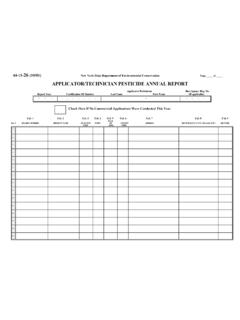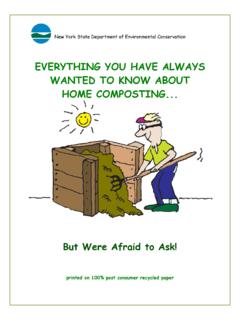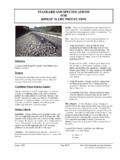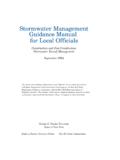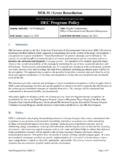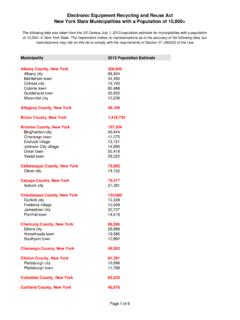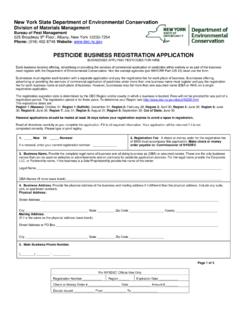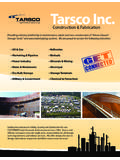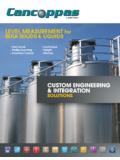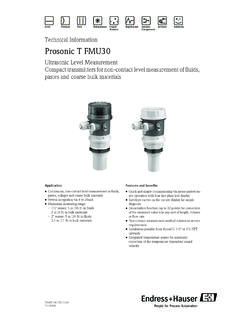Transcription of Tank IQ: Training Guide for Class A and B UST Operators
1 June 2017 Rev Training Guide For Class A and B UST OperatorsPetroleum and Chemical bulk Storage Programs Bureau of Technical Support Division of Environmental Remediation adsfsadf i New York UST Operator Training Program | New York State Department of Environmental Conservation | June 2017 Table of Contents Table of Contents Introduction .. 1-1 Why Does New York Require UST Operator Testing? .. 1-1 Applicability .. 1-2 Training and Testing: Timing Requirements .. 1-3 Operator Testing Requirements .. 1-4 Red Tags Regulatory Consequences of Releases or Serious Deficiencies.
2 1-4 Summary .. 1-5 Operator Training Requirements and Deadlines .. 2-1 Class A Operator .. 2-1 Class B Operator .. 2-2 Becoming an Authorized Operator .. 2-2 When Do I Need To Be Authorized? .. 2-4 Class C Operator .. 2-5 Documentation .. 2-6 Operator Database .. 2-6 Retirement of Authorization .. 2-6 Summary .. 2-7 Tank System Basics .. 3-1 Tank System Categories According to Installation Dates .. 3-4 Tank Construction .. 3-4 Tank Configurations .. 3-6 Documentation of Tank System Installation.
3 3-19 Petroleum Tank Registration .. 4-1 Definition of Petroleum .. 4-1 Regulated Facilities .. 4-2 adsfsadf ii New York UST Operator Training Program | New York State Department of Environmental Conservation | June 2017 Table of Facility Owner .. 4-4 Notification of Tank Installation at a New Facility .. 4-4 Registration of New 4-4 Registration Certificate .. 4-5 Renewal .. 4-5 Transfer .. 4-5 Registration of Additional or Replacement tanks .. 4-5 Information Correction.
4 4-6 Tank Closure .. 4-6 Summary: .. 4-6 Financial Responsibility .. 5-1 Meeting the Financial Responsibility Requirement .. 5-1 Reporting and Recordkeeping .. 5-3 Summary .. 5-4 Out-of-Service tanks and Permanent Closure .. 6-1 Out-of-Service Tank Systems .. 6-1 Permanent Tank Closure .. 6-2 Change in Service .. 6-3 Tank Systems Improperly Taken Out-of-Service before 12/27/1986 .. 6-3 Closure Records .. 6-4 Registration Update .. 6-4 Summary .. 6-4 Overfill Prevention .. 7-1 Mechanical Overfill Device.
5 7-3 Electronic Overfill Alarms .. 7-5 Inventory Monitoring .. 8-1 Daily Inventory Monitoring What To Do Each Day .. 8-2 What To Do At Least Every 10 Days .. 8-8 Leak Reporting .. 8-13 Recordkeeping .. 8-13 adsfsadf iii New York UST Operator Training Program | New York State Department of Environmental Conservation | June 2017 Table of Summary .. 8-13 Tank Leak Detection .. 9-1 Leak detection for Category 2 and 3 tanks .. 9-2 Leak Detection for Category 1 tanks .. 9-4 Maintenance and Operation of Leak Detection Equipment .. 9-11 Recordkeeping.
6 9-11 Tank Tightness Testing .. 9-12 Leak Reporting .. 9-13 Leak Investigation and Confirmation .. 9-13 Summary .. 9-13 Piping Leak Detection .. 10-1 Pressurized vs. Suction Piping Systems .. 10-2 Leak Detection: Category 3 Tank Systems and New Piping .. 10-3 Leak Detection: Existing Piping Connected to Category 1 or 2 Tank Systems .. 10-11 Operation and Maintenance of Piping Leak Detection Equipment .. 10-12 Leak Reporting and Investigation .. 10-12 Recordkeeping .. 10-13 Summary .. 10-14 Cathodic Protection (Corrosion Protection) .. 11-1 Cathodic Protection Requirements.
7 11-2 Galvanic Systems .. 11-3 Impressed Current Systems .. 11-3 Inspection and Testing .. 11-4 Repairs to Cathodic Protection Systems .. 11-6 Recordkeeping .. 11-6 Summary .. 11-6 Dispensers .. 12-1 Dispensing Equipment .. 12-3 Under-dispenser Containment .. 12-4 adsfsadf iv New York UST Operator Training Program | New York State Department of Environmental Conservation | June 2017 Table of Valves .. 12-5 Accidents .. 12-9 Calibration .. 12-9 Summary .. 12-9 Spill Prevention and fill ports .. 13-1 Maintenance.
8 13-2 Common Issues .. 13-3 Tank Tags .. 13-3 Fill Port Color Coding .. 13-4 Spill Reporting and Response .. 14-1 Signs of a Spill or Release .. 14-2 Investigating Possible Spills .. 14-2 Reporting Spills and Releases .. 14-4 Minor Spill Response Actions .. 14-6 Release Response, Investigation, and Corrective Action .. 14-7 Corrective Action Plan .. 14-11 Public Participation .. 14-11 Recordkeeping .. 14-11 Summary .. 14-12 UST System Recordkeeping .. 15-1 Record Storage.
9 15-2 Record Accessibility .. 15-3 Required Records .. 15-3 Summary .. 15-5 Operation and Maintenance .. 16-1 Day to Day Operations - What Do I Need To Do? .. 16-1 Inspections .. 16-3 Maintenance and Repairs .. 16-4 Reminder of Required Ongoing Activities for USTs .. 16-4 Summary .. 16-7 adsfsadf v New York UST Operator Training Program | New York State Department of Environmental Conservation | June 2017 Table of Contents Tank System Compatibility .. 17-1 Definition of Compatibility .. 17-1 Why Does Compatibility Matter?
10 17-2 Types of Equipment Compatibility .. 17-3 Steps to Confirm Compatibility .. 17-3 When Does Compatibility Matter? .. 17-4 Summary .. 17-4 Training of Class C Operators .. 18-1 Training .. 18-2 Recordkeeping: .. 18-6 Summary: .. 18-7 Chemical bulk Storage Requirements .. 19-1 Definition of Hazardous Substance .. 19-1 CBS Registration .. 19-2 Sale of Hazardous Substances .. 19-2 Inspections and Monitoring .. 19-2 Spills and Releases .. 19-2 Spill Response Plan and Annual Compliance Evaluations .. 19-3 Other Requirements.
